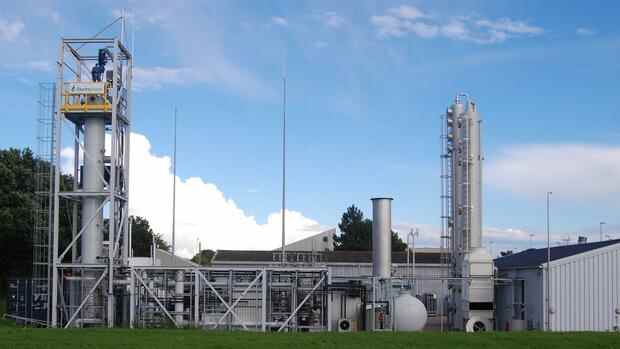The start-up has now built several pilot plants on an industrial scale. Source: Electrochaea
Dusseldorf The power-to-gas company Electrochaea is about to build a large commercial plant. For this purpose, the Munich-based company is collecting 36 million euros in a financing round, as the Handelsblatt learned in advance. A large part of the money comes from the European Innovation Council Fund (EIC Fund), which is investing 14.9 million euros. Existing investors such as the energy technology company Baker Hughes or the venture capital fund btov contribute the rest.
Electrochaea has developed a technology that blends wonderfully into the existing infrastructure, says Christian Reitberger, partner at investor btov and board member at Electrochaea. “Now it’s about upscaling the technology and using it commercially in large industrial plants.”
Power-to-gas is a central approach that is intended to drive the energy transition. With the help of electricity from water, hydrogen is first obtained through electrolysis. This can store energy for a long time, which can be turned back into electricity if it is needed in a dark doldrums with less solar and wind energy.
In a second step, however, this hydrogen can also be converted into methane – and functions like normal natural gas. “The quality is the same as that of fossil gas. In contrast to hydrogen, it can be fed into the gas network without any special precautions, ”says Doris Hafenbradl, CTO and Managing Director at Electrochaea.
Top jobs of the day
Find the best jobs now and
be notified by email.
To make the methane, Electrochaea uses a special type of microorganism. “Archaea live in extreme environmental conditions such as geysers,” says Hafenbradl. “They use hydrogen as an energy source and CO2 as a carbon source and turn it into methane.”
“Germany is currently still a challenge”
The archaea have existed since ancient times. However, they have only been used in methane production machines for a few years. The idea and the particularly efficient archaea strain on which the Electrochaea technology is based was developed by US professor Laurens Mets in 2006 at the University of Chicago. He did not find any interested investors in the USA. “Gas was so cheap there that nobody thought about renewable gas,” says Hafenbradl.
The idea on which the Electrochaea technology is based was developed by US professor Laurens Mets in 2006 at the University of Chicago. Source: Electrochaea
It was different in Germany: Electrochaea GmbH was founded in 2014 with three employees and collected its start-up capital from seven investors. Since then, the start-up has grown to 30 employees and has built several pilot plants on an industrial scale. It is now collecting money for the fourth time. With the money from this so-called Series D financing round, Electrochaea wants to build a plant with an electrolysis capacity of ten megawatts.
However: Germany is benefiting little from the progress made by the Munich start-up for the time being. The company’s pilot plants are located abroad – in the USA, Switzerland and Denmark. And the new project is also being built in Roslev, Denmark. In Germany the conditions are just too bad. “We would like to build systems in Germany too,” says Hafenbradl. “But Germany is currently still a challenge – even if politicians are now trying to create the appropriate framework conditions.” There are two main reasons for this: the high electricity costs and the regulatory framework.
Jeannette Uhlig, team leader for climate-neutral energy sources at the German Energy Agency (Dena), explains what the problem is: “To produce hydrogen, you need a lot of electricity,” she says. “In Germany, electricity has so far been a comparatively large cost factor because of the high levies, taxes and the EEG surcharge.”
The regulatory situation in Germany is difficult because it is unclear whether e-gas like that from Electrochaea will be recognized as biomethane. Only then could fuel manufacturers, for example, buy the methane in order to meet the EU’s statutory greenhouse gas quotas and thus become more environmentally friendly.
Various corporations have already announced electrolysers that are significantly larger than ten megawatts. Shell, Mitsubishi and Vattenfall are planning a hydrogen project with 100 megawatts in Hamburg by 2025. However, according to expert Uhlig, plants in Germany that use electricity to produce methane mostly only have outputs in the kilowatt range. That should only change when the market conditions in this country improve. That’s not enough for Electrochaea’s latest project.
More: Intelligent networks, short-term storage, power-to-gas – these technologies are crucial for the climate change

